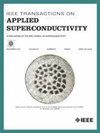考虑到一般赛道线圈的超导直线电机多目标优化方案
IF 1.7
3区 物理与天体物理
Q3 ENGINEERING, ELECTRICAL & ELECTRONIC
引用次数: 0
摘要
为了提高山梨试验线上电动悬挂(EDS)列车的乘坐舒适性,考虑到一般赛道线圈的几何形状,对气芯超导直线同步电机(SLSM)进行了优化,以减少推力波纹。首先,给出了一个基于一般赛道线圈的分析模型,用于计算 SLSM 的推力,其中考虑了椭圆效应边缘。其次,将分析模型与响应面法相结合,得出了一个代用模型,用六个变量来表示推力。第三,以代用模型作为遗传优化算法的拟合函数,对 SLSM 进行多目标优化。第四,通过有限元模型对优化后的 SLSM 的推力波纹进行评估,并将其与原始推力波纹进行比较,同时考虑到 EDS 列车的多自由度运动导致的次级姿态变化。最后,通过测量推力来验证优化结果。结果,在推力和材料消耗不变的情况下,SLSM 的推力波纹减少了 49%。在这项工作中,对 SLSM 进行了优化,以提高山梨试验线和未来 EDS 系统的舒适性。本文章由计算机程序翻译,如有差异,请以英文原文为准。
Multiobjective Optimization of Superconducting Linear Motor Considering General Racetrack Coils
To improve the ride comfort of an electrodynamic suspension (EDS) train on the Yamanashi test line, an optimization of the air-cored superconducting linear synchronous motor (SLSM) is conducted to reduce the thrust ripple, considering the geometry of general racetrack coils. First, an analytical model based on general racetrack coils is given to calculate the thrust of the SLSM, which takes the elliptic effect edges into consideration. Second, combining the analytical model with the response surface method, a surrogate model is yielded to express the thrust with six variables. Third, the multiobjective optimization of the SLSM is carried out, taking the surrogate model as the fitness function of the genetic optimization algorithm. Fourth, the thrust ripple of the optimized SLSM is evaluated by finite-element models and compared with that of the original, considering the variable postures of the secondary resulting from the multi-degree-of-freedom motions of the EDS train. Finally, the optimization is verified by the measured thrust. Consequently, the thrust ripple of the SLSM is reduced by 49% with the invariant thrust and material consumption. In this work, an optimization of the SLSM is provided to enhance the comfort of the Yamanashi test line and the future EDS system.
求助全文
通过发布文献求助,成功后即可免费获取论文全文。
去求助
来源期刊

IEEE Transactions on Applied Superconductivity
工程技术-工程:电子与电气
CiteScore
3.50
自引率
33.30%
发文量
650
审稿时长
2.3 months
期刊介绍:
IEEE Transactions on Applied Superconductivity (TAS) contains articles on the applications of superconductivity and other relevant technology. Electronic applications include analog and digital circuits employing thin films and active devices such as Josephson junctions. Large scale applications include magnets for power applications such as motors and generators, for magnetic resonance, for accelerators, and cable applications such as power transmission.
 求助内容:
求助内容: 应助结果提醒方式:
应助结果提醒方式:


